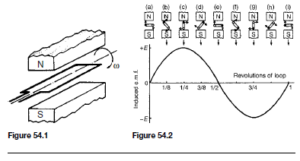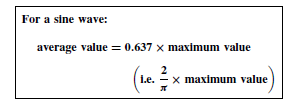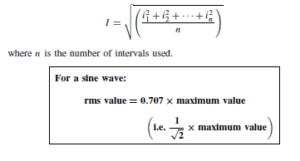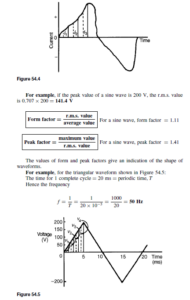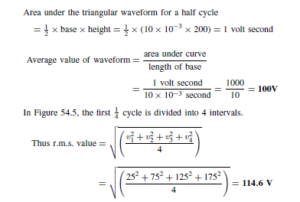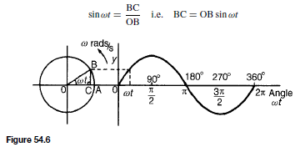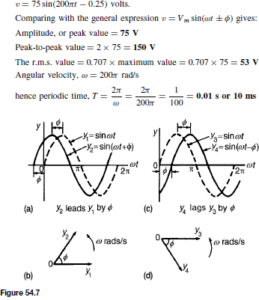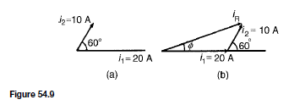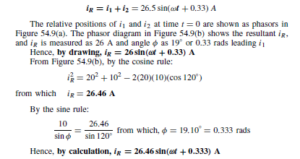Introduction
Electricity is produced by generators at power stations and then distributed by a vast network of transmission lines (called the National Grid system) to industry and for domestic use. It is easier and cheaper to generate alternating current (a.c.) than direct current (d.c.) and a.c. is more conveniently distributed than d.c. since its voltage can be readily altered using transformers. Whenever d.c. is needed in preference to a.c., devices called rectifiers are used for conversion (see chapter 51).
The a.c. Generator
Let a single turn coil be free to rotate at constant angular velocity symmetrically between the poles of a magnet system as shown in Figure 54.1.
An e.m.f. is generated in the coil (from Faraday’s laws) which varies in magnitude and reverses its direction at regular intervals. The reason for this is shown in Figure 54.2. In positions (a), (e) and (i) the conductors of the loop are effectively moving along the magnetic field, no flux is cut and hence no e.m.f. is induced. In position (c) maximum flux is cut and hence maximum e.m.f. is induced. In position (g), maximum flux is cut and hence maximum e.m.f. is again induced. However, using Fleming’s right-hand rule, the induced
e.m.f. is in the opposite direction to that in position (c) and is thus shown as ÐE. In positions (b), (d), (f) and (h) some flux is cut and hence some e.m.f. is induced. If all such positions of the coil are considered, in one revolution of the coil, one cycle of alternating e.m.f. is produced as shown. This is the principle of operation of the a.c. generator (i.e. the alternator).
Waveforms
If values of quantities that vary with time t are plotted to a base of time, the resulting graph is called a waveform. Some typical waveforms are shown in Figure 54.3. Waveforms (a) and (b) are unidirectional waveforms, for, although they vary considerably with time, they flow in one direction only (i.e. they do not cross the time axis and become negative). Waveforms (c) to (g) are called alternating waveforms since their quantities are continually changing in direction (i.e. alternately positive and negative).
A waveform of the type shown in Figure 54.3(g) is called a sine wave. It is the shape of the waveform of e.m.f. produced by an alternator and thus the mains electricity supply is of ‘sinusoidal’ form.
One complete series of values is called a cycle (i.e. from O to P in Figure 54.3(g)).
The time taken for an alternating quantity to complete one cycle is called the period or the periodic time, T, of the waveform.
The number of cycles completed in one second is called the frequency, f, of the supply and is measured in hertz, Hz. The standard frequency of the electricity supply in Great Britain is 50 Hz
A.c. Values
Instantaneous values are the values of the alternating quantities at any instant of time. They are represented by small letters, i, v, e, etc., (see Figures 54.3(f) and (g)).
The largest value reached in a half cycle is called the peak value or the maximum value or the crest value or the amplitude of the waveform. Such values are represented by Vm , Im , Em , etc. (see Figures 54.3(f) and (g)). A peak-to-peak value of e.m.f. is shown in Figure 54.3(g) and is the difference between the maximum and minimum values in a cycle.
The average or mean value of a symmetrical alternating quantity, (such as a sine wave), is the average value measured over a half cycle, (since over a complete cycle the average value is zero).
The area under the curve is found by approximate methods such as the trapezoidal rule, the mid-ordinate rule or Simpson’s rule. Average values are represented by VAV, IAV , EAV , etc.
For example, if the peak value of a sine wave is 200 V, the average or mean value is 0.637 x 200 = 127.4 V
The effective value of an alternating current is that current which will produce the same heating effect as an equivalent direct current. The effective value is called the root mean square (r.m.s.) value and wheneve an alternating quantity is given, it is assumed to be the r.m.s. value. For example, the domestic mains supply in Great Britain is 240 V and is assumed to mean ‘240 V r.m.s.’. The symbols used for r.m.s. values are I, V, E, etc. For a non-sinusoidal waveform as shown in Figure 54.4 the r.m.s. value is given by:
(Note that the greater the number of intervals chosen, the greater the accu- racy of the result. For example, if twice the number of ordinates as that chosen above are used, the r.m.s. value is found to be 115.6 V)
The Equation of a Sinusoidal Waveform
In Figure 54.6, OA represents a vector that is free to rotate anticlockwise about O at an angular velocity of ω rad/s. A rotating vector is known as a phasor.
After time t seconds the vector OA has turned through an angle ωt. If the line BC is constructed perpendicular to OA as shown, then
If all such vertical components are projected on to a graph of y against angle ωt (in radians), a sine curve results of maximum value OA. Any quantity that varies sinusoidally can thus be represented as a phasor.
A sine curve may not always start at 0°. To show this a periodic function is represented by y = sin(ωt š ¢), where ¢ is the phase (or angle) difference compared with y = sin ωt. In Figure 54.7(a), y2 = sin(ωt C ¢) starts ¢ radians earlier than y1 = sin ωt and is thus said to lead y1 by ¢ radians. Phasors y1 and y2 are shown in Figure 54.7(b) at the time when t = 0.
In Figure 54.7(c), y4 = sin(ωt Ð ¢) starts ¢ radians later than y3 = sin ωt and is thus said to lag y3 by ¢ radians. Phasors y3 and y4 are shown in Figure 54.7(d) at the time when t = 0.
Given the general sinusoidal voltage
(i) Amplitude or maximum value = Vm
(ii) Peak to peak value = 2Vm
(iii) Angular velocity = ω rad/s
(iv) Periodic time, T = 2n/ω seconds
(v) Frequency, f = ω/2n Hz (since ω = 2nf)
(vi) angle of lag or lead (compared with v = Vm sin ωt)
For example, an alternating voltage is given by:
Combination of Waveforms
The resultant of the addition (or subtraction) of two sinusoidal quantities may be determined either:
(a) by plotting the periodic functions graphically, or
(b) by resolution of phasors by drawing or calculation
The resultant waveform for i1 C i2 is shown by the broken line in Figure 54.8. It has the same period, and hence frequency, as i1 and i2. The amplitude or peak value is 26.5 A. The resultant waveform leads the curve i1 D 20 sin ωt
Hence the sinusoidal expression for the resultant i1 C i2 is given by:
Rectification
The process of obtaining unidirectional currents and voltages from alternating currents and voltages is called rectification. Devices called diodes carry out automatic switching in circuits. Half and full-wave rectifiers are explained in chapter 51.


